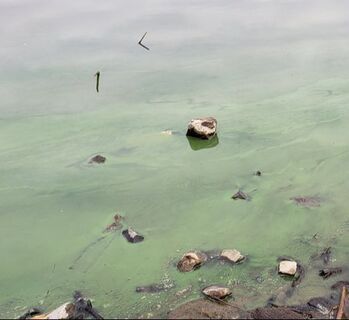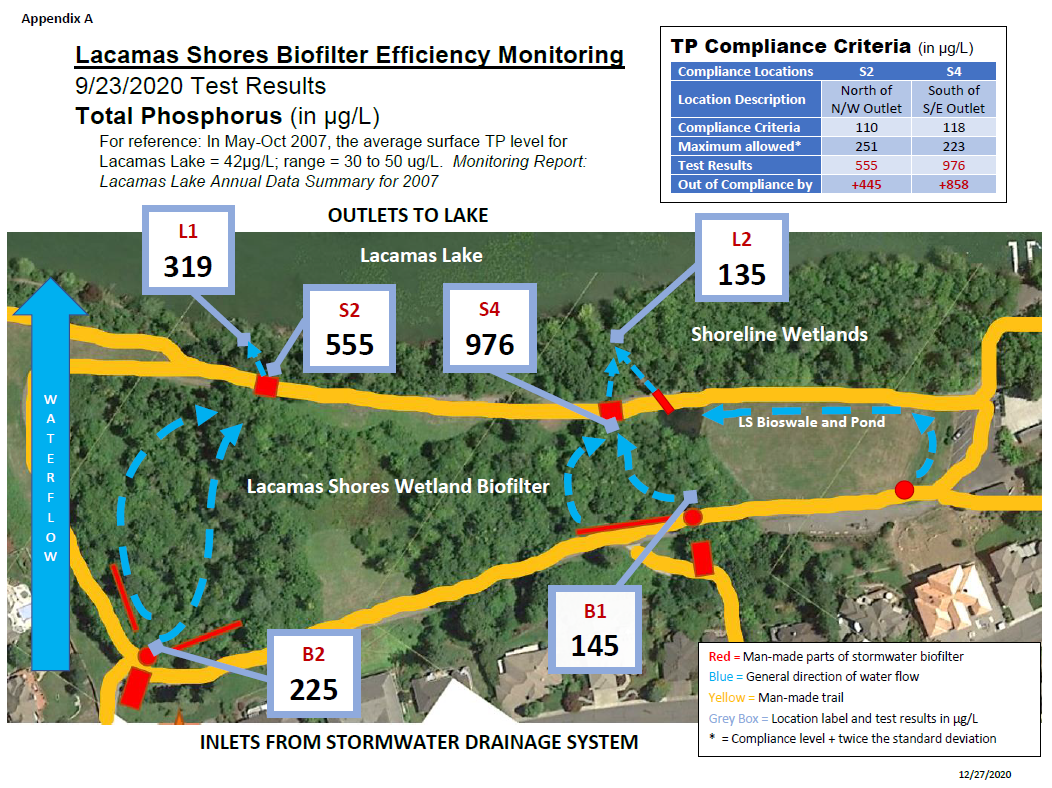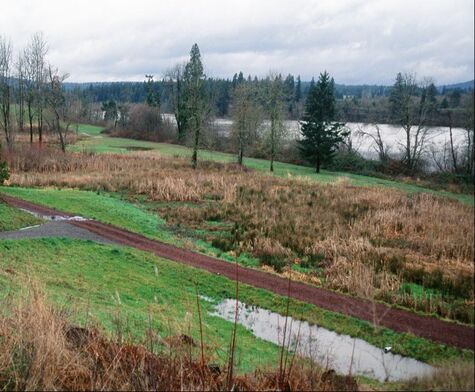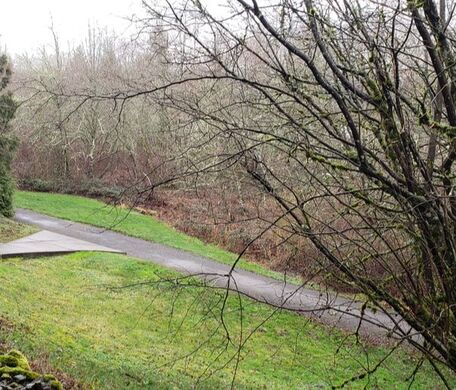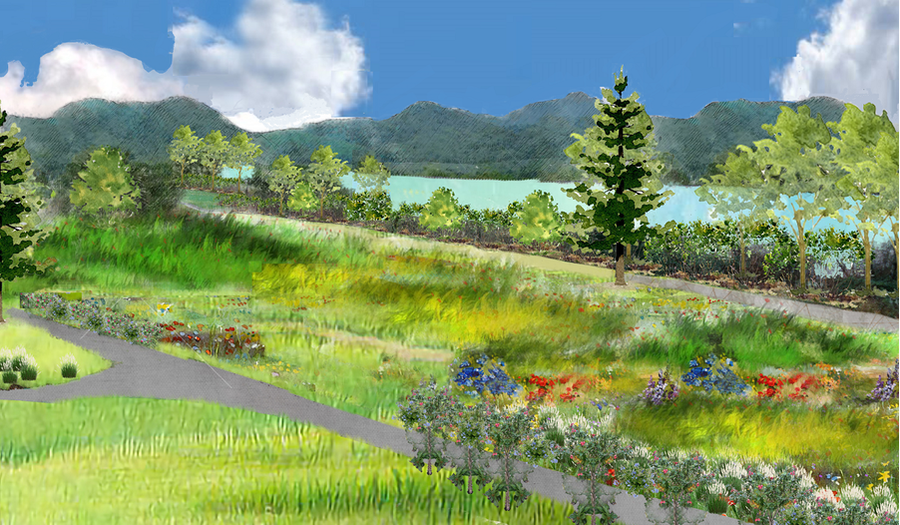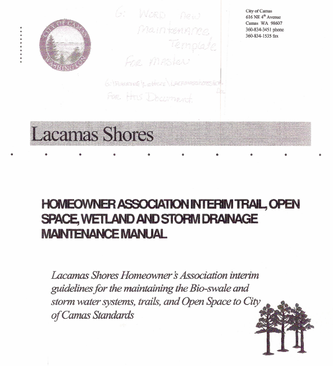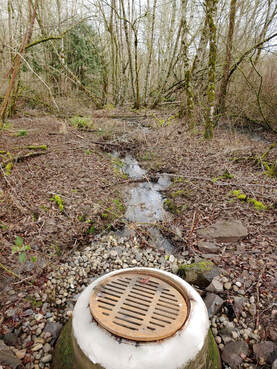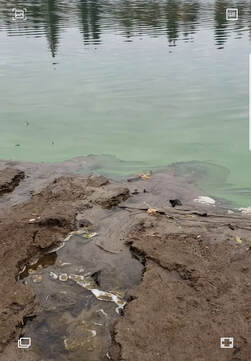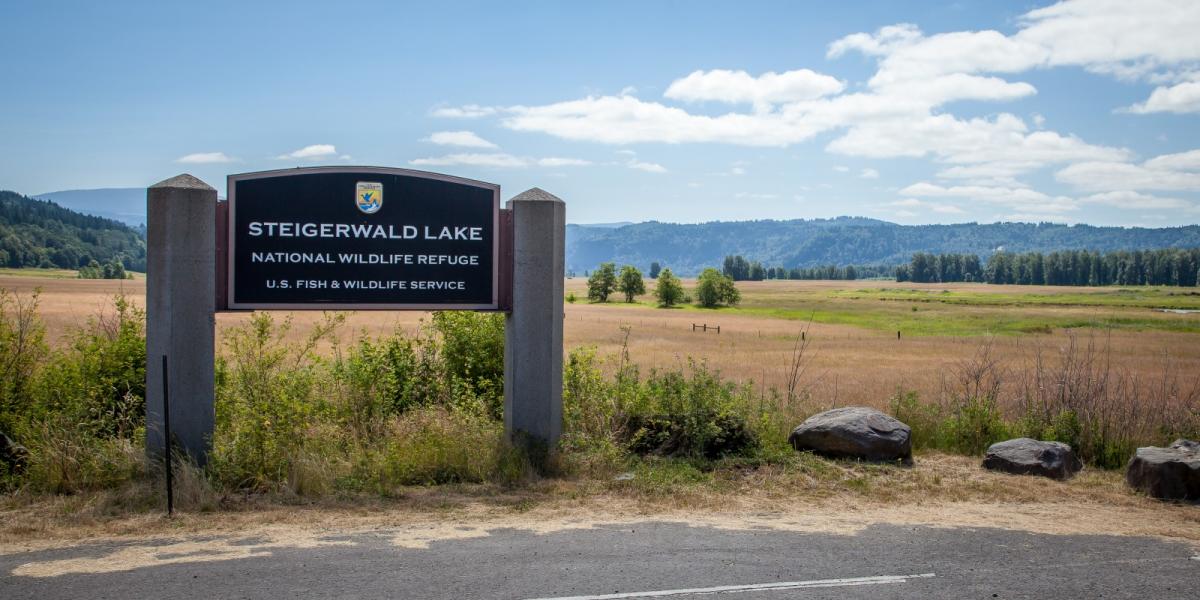Protecting or Polluting Lacamas Lake?The current answer:
This Biofilter is still "Polluting, with no end in sight." 12/18/2023 - CWA Court ruling states that the Biofilter is a "point source" and the HOA can be held liable for its pollution, and characterizes some HOA arguments as "both perplexing and demonstrably false" and "frivolous".
11/20/2023 - Appeals Court confirms ruling that HOA violate its CC&Rs by failing to maintain the Biofilter! Defense asked that trial be pushed to Feb 2024. Will determine damages for CC&R breach and liability for nuisance. For the federal case, maximum CWA fines are calculated $64,618 per day, per outlet, per pollutant. The LS Biofilter has 2 outlets with three known pollutants each. It has been over 1000 days! Let's fix this Biofilter! |
Along our subdivision's shoreline, Oct 2019
Questions? Ask: info@lacamasshoresbiofilter.org Table of Contents
|
The Lacamas Shores Biofilter was constructed to protect the Lake waters in exchange for allowing the Lacamas Shores development, but right now it is the ONLY publicly known point source PROVEN to be exceeding its pollution standards dumping into Lacamas Lake. Its pollution levels are not only over the compliance standards, but double 2x the standard deviations level [that's not a typo]! That's a lot!
The solution is at NO COST to the City and yet, so far, the City has no plans to hold the HOA accountable and stop the pollution!
The solution is at NO COST to the City and yet, so far, the City has no plans to hold the HOA accountable and stop the pollution!

History: The Lacamas Shores Biofilter was the neighborhood's promise not to harm the waters running into the Lake. That promise was given in exchange for permission to destroy Camas' "Black Forest" area to build 250+ luxury homes. But now toxic algae blooms are exponentially increasing in Lacamas Lake every year on the Biofilter's shoreline.
The Biofilter's "filter" has not been "changed" in 30 years and other components of the Biofilter have also not been repaired. The system is broken. It is adding pollutants collected from the past 3 decades back into the unfiltered stormwater flowing directly into the Lake. The LS HOA has fixed some pipes, but there are NO PLANS to return the "filter" to the removable (mowable), dense plant-life required to clean the water. ALL manuals on stormwater treatment wetlands require regular maintenance, including regular removal of vegetation and eventually the built up sediments. They warn that when the plants that filtered the pollutants are left to die off/deteriorate in the winter, they add those pollutants back into the water, making water quality worse.
The Biofilter's "filter" has not been "changed" in 30 years and other components of the Biofilter have also not been repaired. The system is broken. It is adding pollutants collected from the past 3 decades back into the unfiltered stormwater flowing directly into the Lake. The LS HOA has fixed some pipes, but there are NO PLANS to return the "filter" to the removable (mowable), dense plant-life required to clean the water. ALL manuals on stormwater treatment wetlands require regular maintenance, including regular removal of vegetation and eventually the built up sediments. They warn that when the plants that filtered the pollutants are left to die off/deteriorate in the winter, they add those pollutants back into the water, making water quality worse.
|
And that is happening to to the Biofilter. In fact, the only testing of the Biofilter completed in the last 20 years shows that the biofilter is actually making the incoming water worse before it dumps into the Lake.
Lacamas Lake is experiencing increasing toxic algae blooms on the Lacamas Shores shoreline and downstream. Yet, there is no new plan to improve the Biofilter in sight. |
|
Runoff from the Biofilter is so polluted that algae is already growing in the new "streams" running down the Lake during the low water of the October "drawdown". Notice that the algae bloom is 2-3x wider where the Biofilter runoff dumps into the lake.
What it could look like with native wetland flowers and grasses . . .
"Stormwater treatment wetlands are used to capture pollutants in a managed environment so that they will not reach natural wetlands and other ecologically important habitats. In addition, [stormwater wetlands cannot be used as protected wetlands because] vegetation must occasionally be harvested and sediment dredged in stormwater treatment wetlands, further interfering with use for wildlife habitat." - Washington State Dept of Ecology, 2019 Stormwater Management Manual for Western Washington, BMP T10.30.
|
How can you help?
|
For more information:
|
Summary of Facts - The Problem:
It is a Biofilter and Must be "Maintained" to a Specific Standard
It is a Biofilter and Must be "Maintained" to a Specific Standard
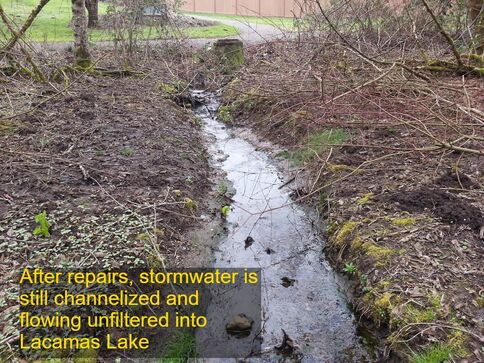
- The Biofilter was built to save Lacamas Lake and the shoreline wetlands from pollution running off Lacamas Shores properties and roadways. (click for details)
- The Biofilter was required due to a 1988 Agreed Order, The Order "establishes the approval of the Dept of Ecology "and directed the City of Camas to issue the permits. (click for details)
- It is the Lacamas Shores HOA's responsibility to maintain the Biofilter and the City's responsibility to not only allow it, but require it. (click for details)
- "Maintenance" for a stormwater treatment wetland requires the regular removal of all vegetation. Such easily-removable vegetation should be high-efficiency filtering grasses and plants, according to the best practices of the DOE, the EPA, and the City's manual written specifically for the Lacamas Shores HOA. Trees are a type of vegetation and, in this case, also "hinder" vegetation removal and regrowth. (click for details).
- Now, 30 years later, with little to no maintenance, the Biofilter is clogged. (click for details)
- This has happened because the Biofilter has been forgotten and fallen through regulatory cracks. The standards set for the Biofilter via permit remain unchecked. (click here)
- Unfortunately, now we are seeing the effect of unfiltered water entering a lake already teetering on the brink of health - MORE TOXIC ALGAE BLOOMS in Lacamas Lake each year! (click here)
- Now what? We need the City to direct the Lacamas Shores HOA to restore the Biofilter to the condition that was required by the permit, for the benefit of all who enjoyed and want to again enjoy Lacamas Lake. (click here)
* Note: In reading the documents involved, it is important to know that the following terms were used interchangeably: "Biofilter storm drainage system" = "man-made wetlands" = "stormwater treatment wetland" = "stormwater drainage system"
Detailed Facts and Proof
1. The Biofilter was built to save the lake from pollution running off future Lacamas Shores lawns and roadways, according to court order and the resulting permit.
The court order called it "man-made wetlands" to be used for a "biofilter storm drainage system". At the time, it was so innovative, the DOE was not sure that it would work.
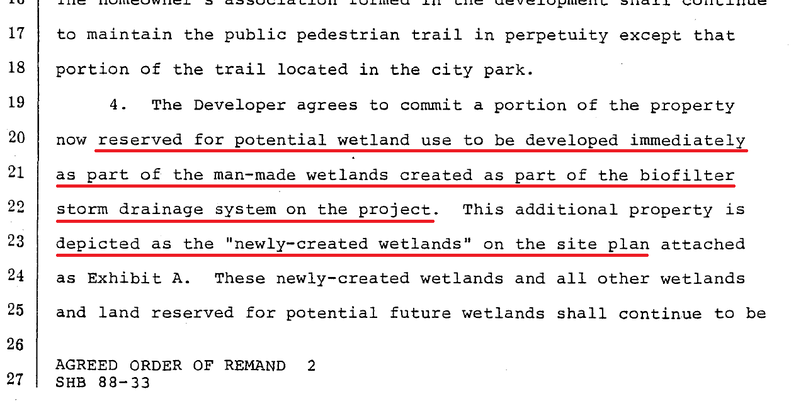
1988 Administrative Court Order (Shoreline Hearing Board)
Clarification:
The area was initially planned to be "newly created wetlands" per the map, but court negotiations changed it instead to the "biofilter storm drainage system".

1988 Permit
“Additional Conditions” were then added to the permit using the same language as the Court Order.
Note the term "biofilter storm drainage system" INCLUDES the "man-made wetlands". Also note that the property shown on the court map marked as "reserved for potential wetland use" AND the property added to the biofilter labeled "man-made wetland" were ALL to be constructed as the Biofilter.
“Additional Conditions” were then added to the permit using the same language as the Court Order.
Note the term "biofilter storm drainage system" INCLUDES the "man-made wetlands". Also note that the property shown on the court map marked as "reserved for potential wetland use" AND the property added to the biofilter labeled "man-made wetland" were ALL to be constructed as the Biofilter.
2. The Biofilter was created according to a 1988 Agreed Order, which directed the City of Camas to issue the permits and established the Dept of Ecology's approval of the permit.
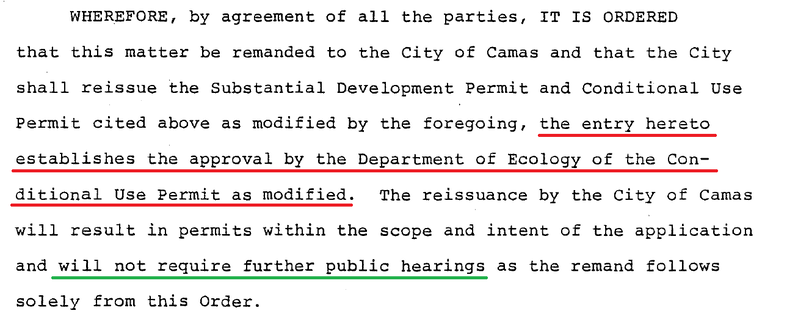
1988 Administrative Court Order (Shoreline Hearing Board)
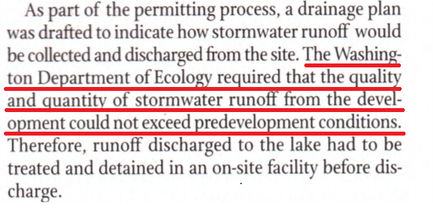
The 1993 article, “Wetlands for Stormwater Treatment” was written about the LS Biofilter and published in the national scientific magazine, "Water, Environment and Technology". It was written based on the court-mandated five years of research and testing of the Biofilter - the theme was its innovative technology. This excerpt states the DOE's position at that time.
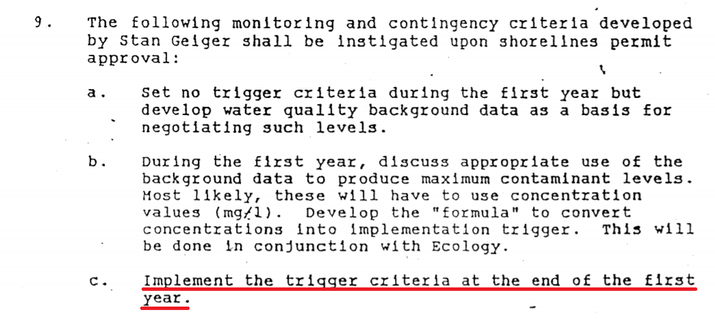
In fact, the DOE felt that clean stormwater was so important to "protecting the shoreline environment" that they had the City add language to the permit requiring water quality standards to be set using the results of the first year of the 5-year monitoring program. See 1988 DOE Letter below
3. It is the Lacamas Shores HOA's responsibility to maintain the Biofilter and the City's responsibility to allow that maintenance AND require it.

1988 Permit mandated the creation of the HOA
for the purpose of maintaining the Biofilter. A monitoring plan was required to 1) test the efficiency of the Biofilter, and 2) set standards for the future. However, the permanent "water quality safeguards" were never acknowledged until recently. This permit requirement came verbatim from a 1988 DOE Letter, concerned with Lacamas Lake water quality. In other words, the permit made it illegal to create the development without an HOA.
for the purpose of maintaining the Biofilter. A monitoring plan was required to 1) test the efficiency of the Biofilter, and 2) set standards for the future. However, the permanent "water quality safeguards" were never acknowledged until recently. This permit requirement came verbatim from a 1988 DOE Letter, concerned with Lacamas Lake water quality. In other words, the permit made it illegal to create the development without an HOA.
The importance of the Biofilter ('wetland") maintenance is reflected in the LSHOA's CC&Rs. CC&Rs are a legal contract amongst Homeowners. The LSHOA CC&Rs allow for any individual Homeowner alone to be held responsible for the entire cost of any "maintenance, repair, and/or restoration".



binds the City to the HOA's responsibility to create and monitor the Biofilter, as well as comply with the conditions in the permit.

The 1993 Permit Revision also acknowledges that the biofilter is a "Stormwater Disposal System" when adding the swale around the soccer field.
4. "Maintenance" for a stormwater treatment wetland requires the regular removal of all vegetation. Such vegetation should be high-efficiency filtering grasses and plants, according to the best practices of the DOE, the EPA, and the City's manual written specifically for the Lacamas Shores HOA. Oversturated alders are a type of vegetation and, in this case, also "hinder" proper vegetation growth and removal.
Without vegetation removal over the last 30 years, all chemicals going into the Biofilter either stayed in the Biofilter, got processed by the Biofilter, or emptied into the Lake. Applicable local, state, and federal manuals on the maintenance of the stormwater facilities are ALL in agreement - each manual:
- Requires periodic "vegetation harvesting" or "removal",
- Requires infrequent removal of the topsoil/sediment build up, and
- Says that trees that "hinder maintenance" should be removed.

Ecology's Stormwater Treatment Manual states the purpose of biofilters, which is to protect natural wetlands. (In our case the shoreline wetlands and the Lake). It notes the need for "harvesting" vegetation to remove the accumulated contaminants while explaining why a treatment wetland cannot also be a natural or mitigation wetland.

See BMP T10.30 on page 10-24 (p.991 of the pdf), or on the DOE website
Note that Table 10.3.1 lists various grasses
Note that Table 10.3.1 lists various grasses
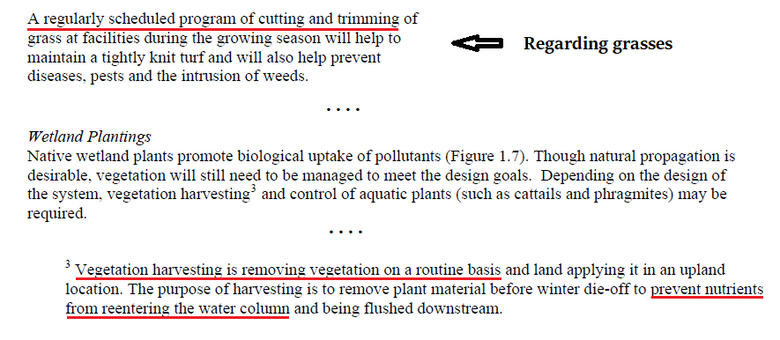
EPA Stormwater Wetpond and Wetland Management Guidelines
Explains the need to remove vegetation. It prevents "diseases, pests, and the intrusion of weeds" and prevents "nutrients from re-entering the water column and being flushed downstream".
Explains the need to remove vegetation. It prevents "diseases, pests, and the intrusion of weeds" and prevents "nutrients from re-entering the water column and being flushed downstream".
It is interesting that plant "nutrients" can become "pollutants" when added to a lake ecosystem. Below, the EPA's warns of the "prevalence of algae blooms", like the continual occurrences adjacent to the Biofilter.
|
Sometimes after 1998, Camas commissioned and published a very specific manual - the Lacamas Shores HOA Maintenance Manual for the Lacamas Shores HOA Biofilter area. It conforms with the state and federal best practices listed above.
|
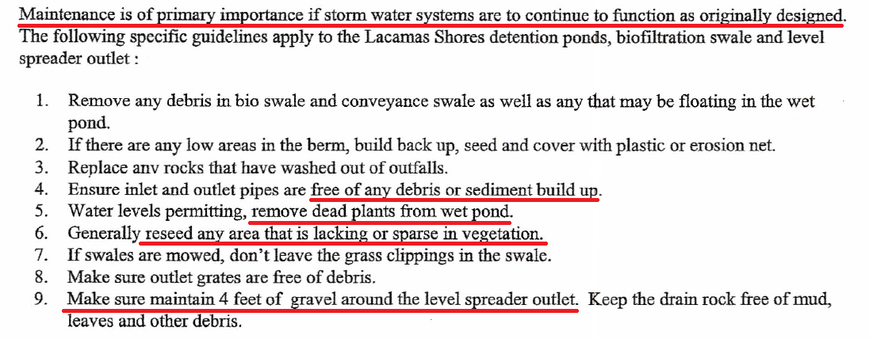
Note #6: the need to reseed bare areas. There are many bare areas due to tree cover.
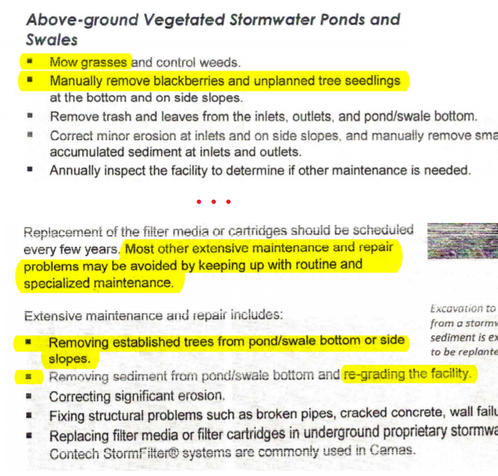
Finally, the City's own 2-page flyer "Stormwater Facility Maintenance Tips" details exactly what is needed. This flyer is sent out to every HOA owning a biofilter, along with their annual Stormwater Facility Inspection Report that details what repairs they must make. It basically says that if you do not do routine maintenance to remove "tree seedlings" you can expect to be required to do extensive maintenance later, requiring a contractor to remove "established trees". Note that what we need done is listed in the first two bullet points for each category. The condition of our Biofilter and the remedy is not a surprise to stormwater experts.
Click here for a list some of the Federal, State, Local and Lacamas Shores manuals on Stormwater Biofilter Maintenance. Spoiler: they all say basically the same thing.
5. Now, 30 years later, with little to no maintenance, the Biofilter is clogged.
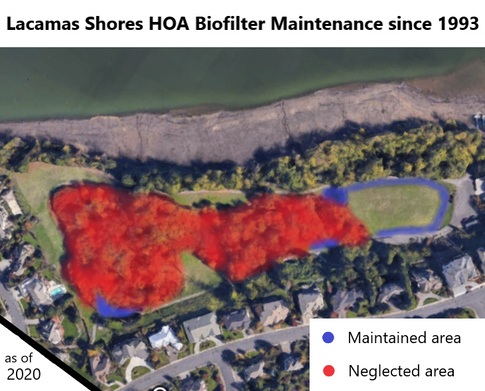
There has been no removal or maintenance other than cleaning out pipes, the sediment pond, and the swale (ditch). The "filter" part of the "Biofilter", i.e., the grasses and aquatic plants in the 5-acre wetland area, has not been maintained. High-filtering tightly knit and easily removable grasses have been crowded out by tree shadow. The trees prevent vegetation and contaminant removal. Leaves and dead plants litter the ground every year, returning the nitrogen, phosphates, etc. back to the system to be washed into the lake.
The data shows the proof - the Biofilter makes the water quality worse!
The data shows the proof - the Biofilter makes the water quality worse!

New Biofilter 1994 Neglected Biofilter 2017
While some pipes have been repaired, there is still no biofiltration going on other than the swale around the soccer field and the sediment pond. Those are just a small portion of the Biofilter.
While some pipes have been repaired, there is still no biofiltration going on other than the swale around the soccer field and the sediment pond. Those are just a small portion of the Biofilter.
|
2020 repairs did not stop the unfiltered flow into the Conservancy Zone wetlands and Lacamas Lake. Note the lack of grasses due to trees blocking the sunlight. Some water did get re-directed to flow across the floor of the Biofilter, but washed 30 years of decay into the Lake. This likely caused the Lake's first ever April algae bloom.
|
|
6. This has happened because the Biofilterwas forgotten and fell through the regulatory cracks. The standards set for the Biofilter via permit remain unchecked.
The governmental agencies that were previously involved lost track of the purpose, history, and legal status of the Biofilter. Compliance standards were set for the Biofilter and then forgotten. The Biofilter was grandfathered out of the 2010 annual testing required for all other stormwater systems, so the only development feeding directly into Lacamas Lake has, as of this moment, no water quality oversight or regulation.
|
On June 6, 1988 the DOE wrote a Letter to the City proposing edits to the Biofilter permit before approval. The DOE's intentions were made clear - protect the shoreline environment, i.e, both Conservancy Zone wetlands and the lake water quality.
|
and
|
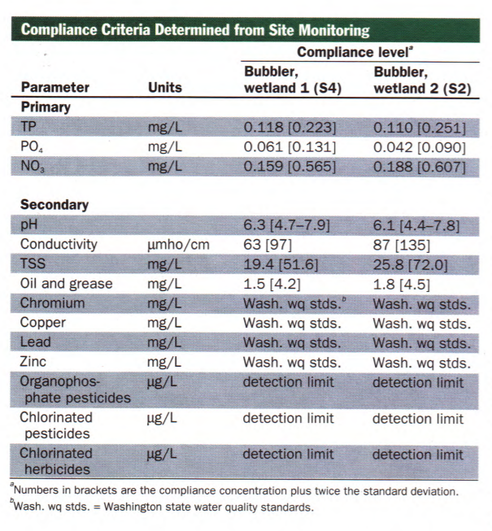
In the letter, the DOE proposed safeguards to protect the "lake water quality" and the shoreline, including:
The HOA is responsible for "monitoring and maintaining" the Biofilter to the those standards.
- Noting that there was a stormwater bypass in case the Conservancy Zone wetlands became too "stressed";
- Requiring all HOA land at that level to be reserved for future biofilter wetland use in case the planned Biofilter was not working well enough;
- Allowing "manipulation" of the "emergent wetlands" (i.e, the biofilter) for the purpose of "enhance the filtering capacity", i.e., making it bigger;
- Establishing "triggers" (standards) for the Biofilter using the 5-year monitoring program;
- Holding back the sale of the lots in the final phase until those triggers were established; and, very importantly,
- Requiring the creation of an HOA to be responsible for continuing the "monitoring and maintenance" of the Biofilter.
The HOA is responsible for "monitoring and maintaining" the Biofilter to the those standards.
Fast forward 30 years later. Despite being given the City's maintenance manual around 1993, by 2014 the was HOA insisting the Biofilter was an untouchable wetland, even after being shown the permit, order and other documents. A Department of Ecology wetland conservation specialist looked at the Biofilter and incorrectly assumed the property was mitigation/natural wetlands. Not knowing about the 1988 letter, the water quality criteria set, or other documents, she wrote the controversial 2018 DOE Opinion Letter. Emails later prove that the City had not provided her all the origination documents. (Click here and go to page 14)

DOE's Rebecca Rothwell, states on the first page that her opinion was CONTINGENT upon there being NO documentation authorizing conversion to stormwater system. Since she was not made aware of the Agreed Order nor the Permit language, she assumed that the property was mitigation and/or natural wetlands and not a stormwater treatment wetland. Based on that false assumption, she gave an opinion confirming the City's prior theory that the property should not be touched, stating she

would be "unlikely to approve" a permit for "tree removal" on page 3 of the letter. Without the proper documents, she came up with the normal conclusion of a conservation specialist. The DOE's Attorney General supported its client's stance without addressing the historical/legal documents.
Now that the City's stormwater experts are involved, we expect that they will gather the information and go to the DOE's stormwater quality people in the DOE's Water Quality branch (instead of the wetland staff) and get guidance to repair the biofilter and protect the water of Lacamas Lake. Technically, the City need not go to the DOE, as any action within the "scope and intent" of the regulating permit is under local jurisdiction, as stated in a 1994 court order, Conclusion IV.
7. Unfortunately, we are seeing the effect of unfiltered stormwater entering a lake teetering on the brink of health - MORE TOXIC ALGAE BLOOMS in Lacamas Lake each year, resulting in more lake closures. Toxic or not, algae blooms are not a good sign.2018 - only 1 bloom
In October 2019 - at least 3 blooms June 28 September 26 October 4 - 13 2020 - continual blooms Between April 10 - October 26, at which point Ecology stopped testing due to funding depletion. |

2021 - 10 blooms with
a Record High Toxin Level of 270µg/L
Over 3x over the prior record of 76 µg/L! Less blooms, but more virulent, possibly indicating that the organisms that eat toxic algae were killed off.
see Ecology's Toxic Algae website
2022 - 10 blooms, with new Record High of 2748 µg/L!!!
That is over 10x the prior high and over 300x the allowable recreation level of 8 µg/L! Again, possibly indicating that the micro-food chain has been damaged by years of toxic blooms.
2023 - Who Knows!?!
If we have a normally warm summer, it could be really bad.
a Record High Toxin Level of 270µg/L
Over 3x over the prior record of 76 µg/L! Less blooms, but more virulent, possibly indicating that the organisms that eat toxic algae were killed off.
see Ecology's Toxic Algae website
2022 - 10 blooms, with new Record High of 2748 µg/L!!!
That is over 10x the prior high and over 300x the allowable recreation level of 8 µg/L! Again, possibly indicating that the micro-food chain has been damaged by years of toxic blooms.
2023 - Who Knows!?!
If we have a normally warm summer, it could be really bad.
While not all algae blooms are tested by the County, all reported algae blooms require testing and any tests that detect toxins above the recommended levels require that recreational use be curtailed. https://www.doh.wa.gov/CommunityandEnvironment/Contaminants/BlueGreenAlgae. Toxic or not, algae blooms are a bad sign for our lake water quality. Click here for the State's Toxic Blue-Green Algae Pamphlet.
8. What to we do now? We need the City to direct the Lacamas Shores HOA to restore the Biofilter to the condition originally required by the permit, in accordance with federal, state and local best practices, for the benefit of all who live near and/or enjoy Lacamas Lake.
|
Reclaim the biofiltering grasslands by removing the vegetation and replant with native mow-able vegetation. Re-create the "filter" with native wetland plants, like the Camas Lily and other plants listed in the manuals for stormwater treatment. See the original plan tendered to the CIty - vision photos start at p.5.
|
We have gone to the City to present these facts and are hoping for action. Click here for our video presentations from August 19, 2019 to the City Council. Steve Bang's presentation is at minute 0:40-10:12, and Marie Tabata-Callerame's is at minute 10:57-21:24. We continue to work with various City personnel and other community leaders to provide the necessary documents and help them to understand the need and path for resolution.
Now, both City and County officials are interested in cleaning the Lake. How that translates into action on the Biofilter is unclear. See the latest video from the City with Mayor Barry McDonnell and Councilman Steve Hogan: https://www.cityofcamas.us/81-city-news/1664-video-update-algae-blooms-in-the-lacamas-lake-system
Now, both City and County officials are interested in cleaning the Lake. How that translates into action on the Biofilter is unclear. See the latest video from the City with Mayor Barry McDonnell and Councilman Steve Hogan: https://www.cityofcamas.us/81-city-news/1664-video-update-algae-blooms-in-the-lacamas-lake-system
Email us to learn how you can help at info@LacamasShoresBiofilter.org!
This website is privately-owned and kept up by neighbors living in the Lacamas Shores community. If you would like to reach the official Lacamas Shores Homeowners' Association website, please go to https://www.LacamasShoresHOA.org.
Site powered by Weebly. Managed by iPage
